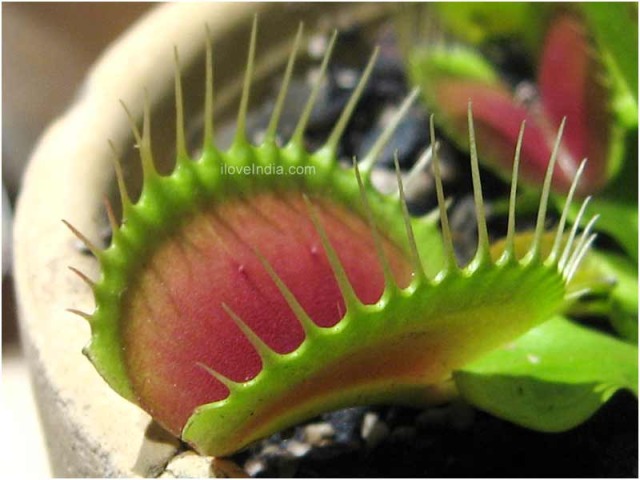Venus flytrap is a carnivorous plant that consumes animal prey, mostly insects and arachnids. Let us explore some interesting facts and amazing information on Venus flytrap.
Facts About Venus Flytrap
Venus flytrap, a plant that is carnivorous in nature, is closely related to the waterwheel plant and sundews. A small plant, it has short subterranean stems, from which grow four to seven leaves, at a time. Depending on the time of year, the stem of this plant attains a maximum size of somewhere between three and ten centimeters. After Venus flytrap reaches a mature stage, there is a possibility of flowers growing on a single tall stalk, much above the leaves. The traps of this plant, which it uses for the purpose of catching its prey, are made up of a pair of terminal lobes hinged at the midrib and can be found at the tip of its leaves. Venus flytraps can live up to 20 years or more. As many of these plants have been uprooted from their habitat, these plants are rare to find. Let us explore some more interesting facts and amazing information on the plants known as Venus flytrap.

Fast Facts
Binomial Name: Dionaea muscipula
Kingdom: Plantae
Division: Magnoliophyta
Class: Magnoliopsida
Order: Caryophyllales
Family: Droseraceae
Genus: Dionaea
Species: D. muscipula
Interesting & Amazing Information on Venus Flytrap
-
Venus flytrap is regarded as one of the small group of plants that is capable of quick movement, the other examples being Mimosa, the Telegraph plant, sundews and bladderworts.
-
The traps of the plant, formed by the terminal portion of its leaves, comprise of tiny hair on their inner surfaces.
-
A prey has to either come in contact with two trigger hair of the plant's trap in succession or touch one of the hairs twice, in order for the lobes to close and catch it.
-
The lobes of Venus flytrap's trap can close in less than 0.1 seconds! However, the exact speed it displays depends upon the amount of humidity and light, size of prey and general growing conditions.
-
If one of the plant's traps catches a very small prey and it manages to escape, the former will reopen within 12 hours.
-
It usually takes around 10 days for a trap of Venus flytrap to digest a single prey.
-
Venus flytrap is native to the wild areas of North and South Carolina, in the United States.
-
The plant catches as well as consumes insects in order to gain nitrogen, which it needs for the purpose of protein formation.
-
The trapping mechanism of Venus flytrap is so sensitive that it can easily differentiate between a living prey and non-prey stimuli, such as falling leaves or raindrops.
-
After trapping the prey, if the trap of the plant experiences any movement, it shuts more tightly and fastens the digestion process as well.
-
In Venus flytrap, the digestive process is catalyzed by enzymes that are secreted by glands in its lobes.
-
Venus flytrap, by its very nature, is a swamp plant and it is very difficult to grow it at home.
-
Till date, Venus Flytrap is considered to be a carnivorous plant that is most commonly recognized and cultivated.
-
A large number of cultivars of the plant have been evolved till date, through tissue culture of select genetic mutations.
-
Venus flytraps can also capture and digest frogs.
-
Each flytrap can consume about 4 to 6 preys, after which the trap dies.
-
Each lobe of a flytrap has six sensitive or trigger hairs.
-
This carnivorous plant can produce its food through photosynthesis, but these consume insects for important nutrients.
-
Venus flytraps have white flowers.
-
Venus flytraps require 14 hours of sunlight every day and 80% humidity for it to survive.
-
Most people grow these at home as houseplants.
-
These plants are threatened by habitat loss and over-collection.
-
Flytraps have a dormancy period that lasts from four to five months. During this time, these plants require very less water.
See also
More from iloveindia.com
- Home Remedies | Ayurveda | Vastu | Yoga | Feng Shui | Tattoos | Fitness | Garden | Nutrition | Parenting | Bikes | Cars | Baby Care | Indian Weddings | Festivals | Party ideas | Horoscope 2015 | Pets | Finance | Figures of Speech | Hotels in India : Delhi | Hyderabad | Chennai | Mumbai | Kolkata | Bangalore | Ahmedabad | Jaipur
- Contact Us Careers Disclaimer Privacy Policy Advertise With Us Lifestyle Sitemap Copyright iloveindia.com. All Rights Reserved.



